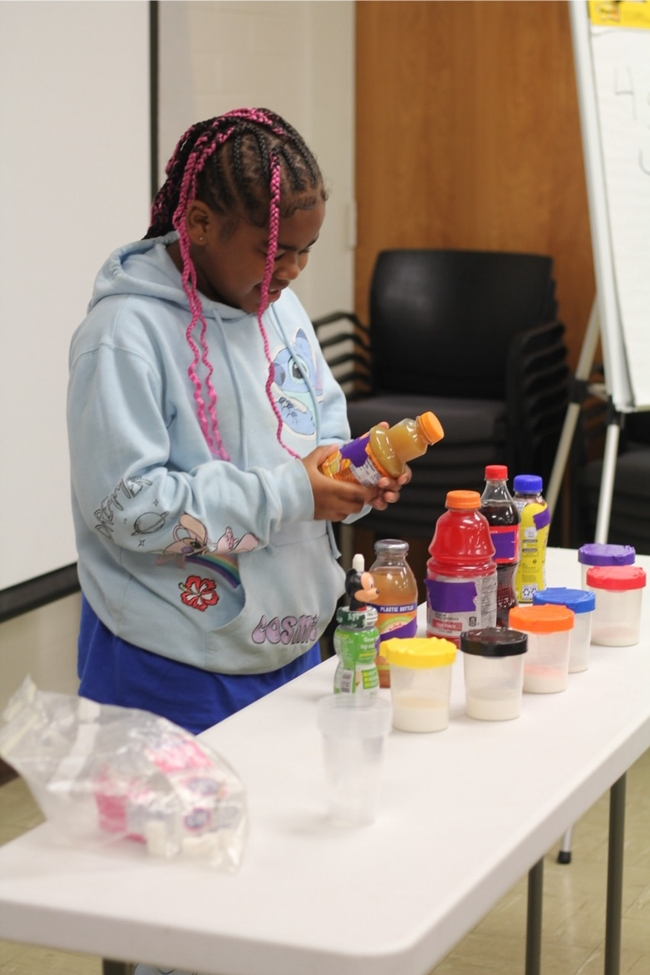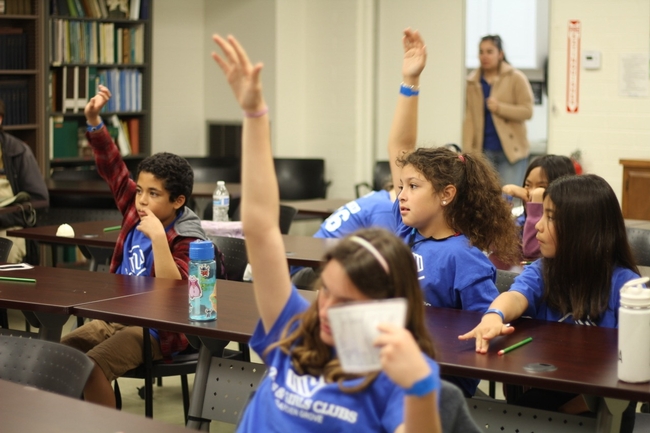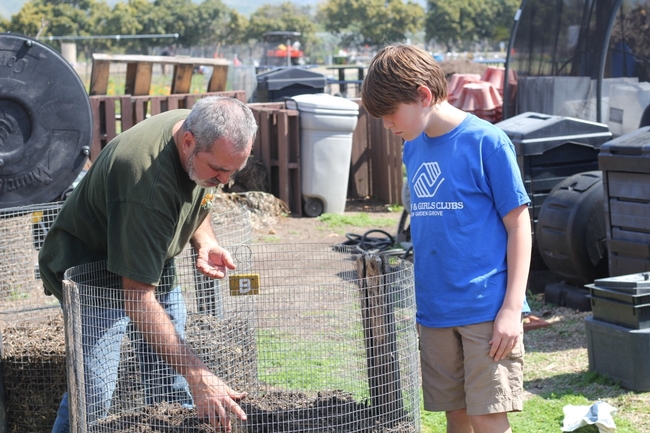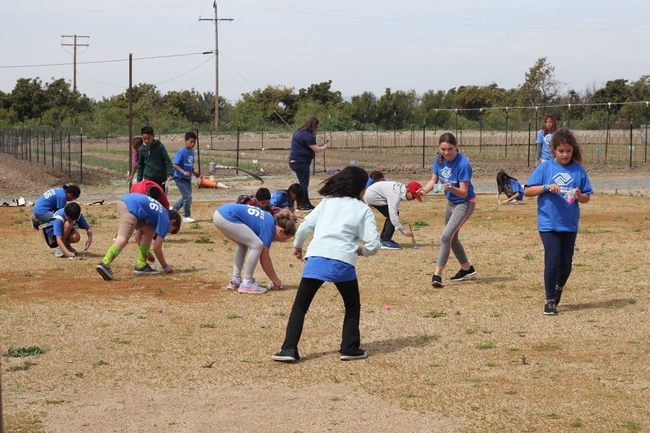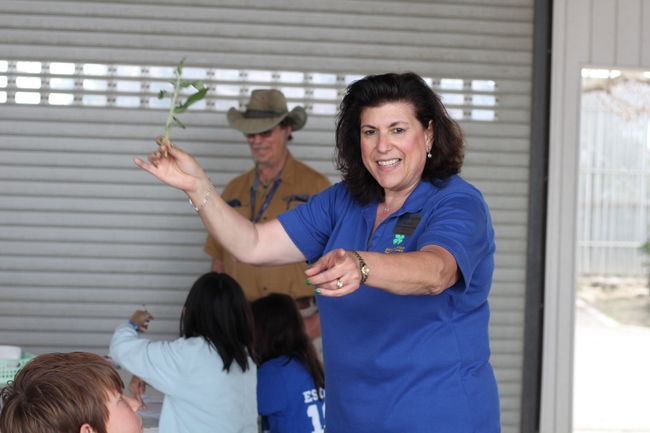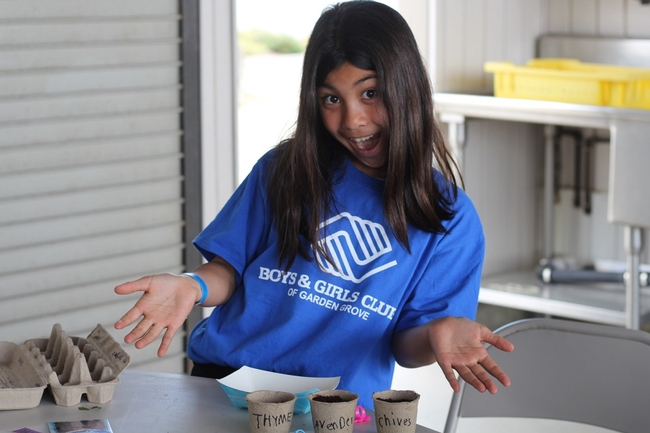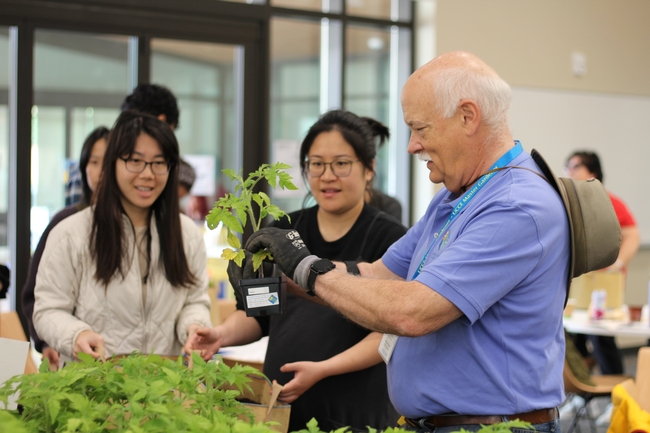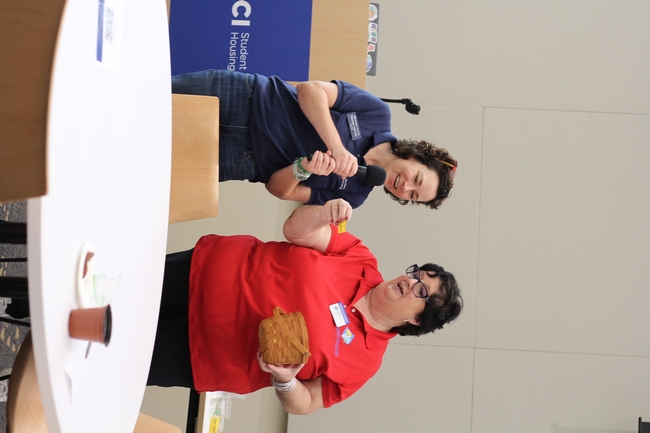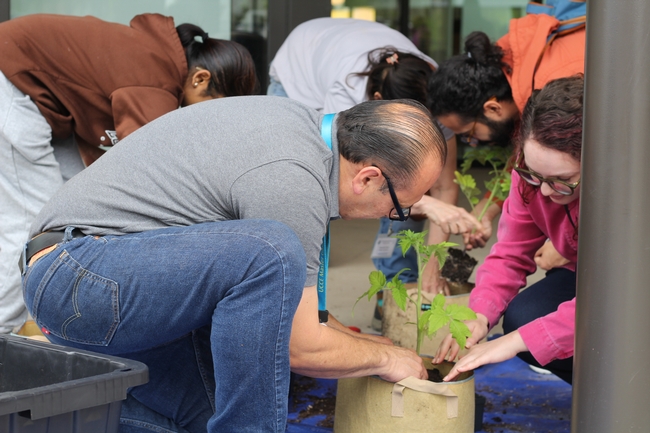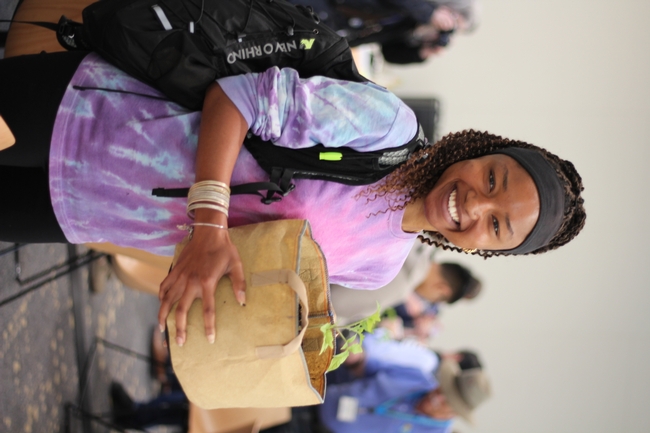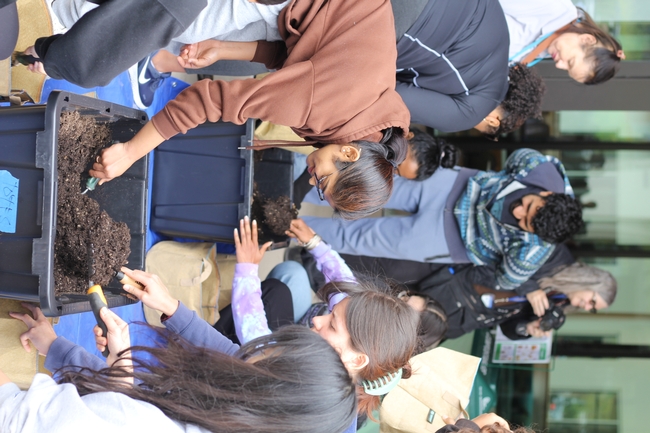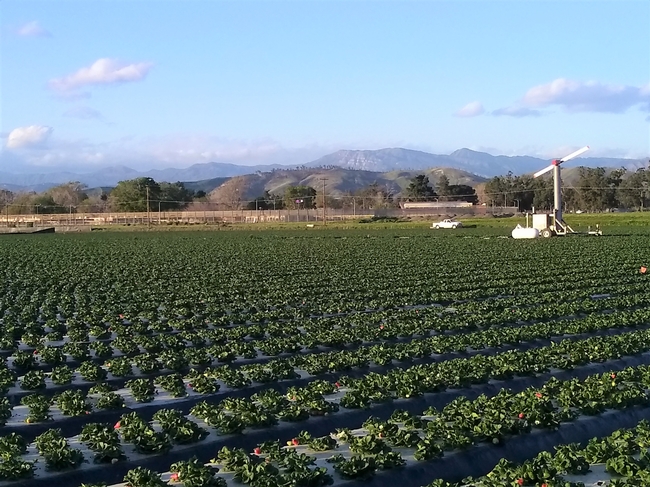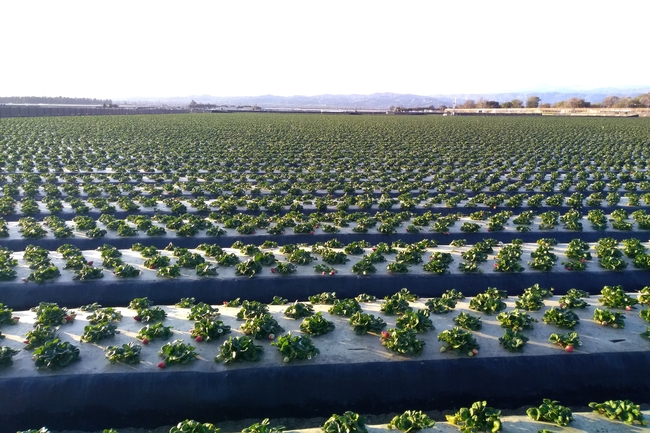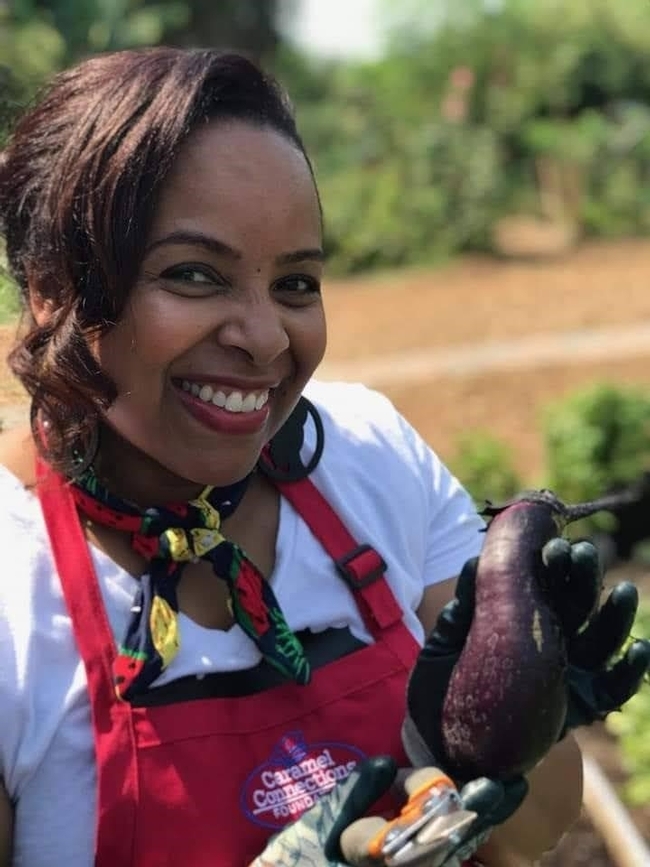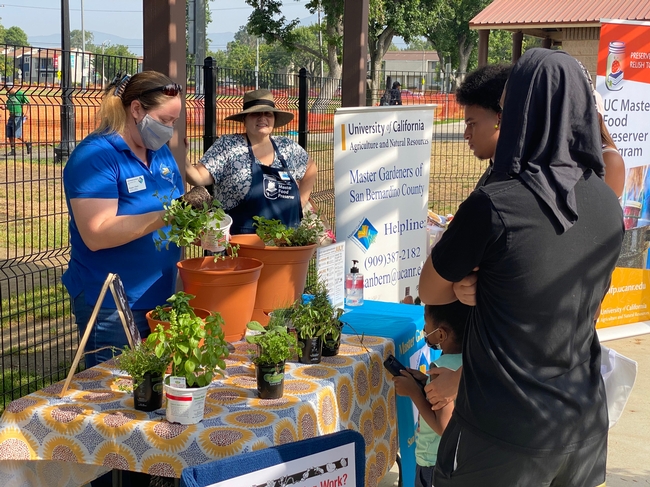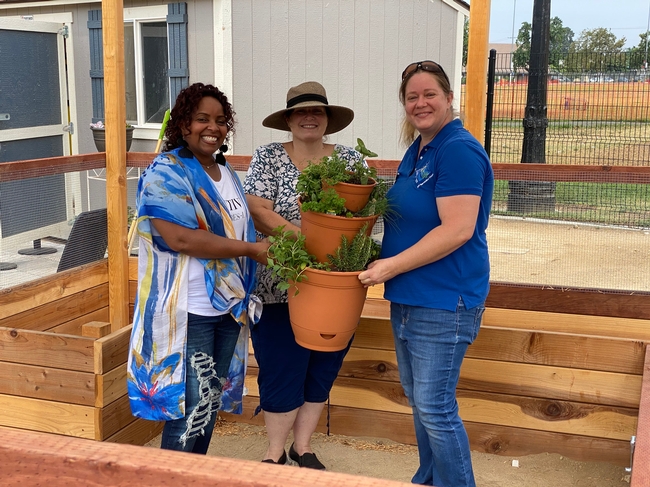Posts Tagged: Master Gardener
4-H, Boys and Girls Club, UCCE partner to inspire Orange County kids
Small containers with varying levels of sugar sit next to a row of beverages, including water, fruit juices, soda, a sports drink and chocolate milk. Trying to match each container with the beverage that contains its corresponding amount of sugar, Amore, a fourth grader, reads the nutrition label on the orange juice bottle. “What does the bottle say?” asked a student in the audience, attempting to help Amore.
Life skills such as how to read a nutrition label are representative of learning that youth can expect when joining 4-H, a nationwide program focused on empowering kids ages 5 to 18. 4-H offers experiential learning opportunities ranging from STEM (Science, Technology, Engineering and Mathematics) and healthy living to civic engagement and leadership.
To expand its reach and make their program more accessible, 4-H launched a digital learning platform called CLOVER by 4-H that offers content tailored for three types of users: learner, parent and educator. As the platform grows in popularity, 4-H is eager to identify best practices in engaging new users to join the platform and retain their interest.
More than 250 free 4-H lessons
In California, 4-H programs are overseen by University of California Agriculture and Natural Resources. Given its successful contributions to statewide initiatives in the past, 4-H in Orange County, administered through the local UC Cooperative Extension office, was one of three counties selected to participate in a CLOVER pilot project in conjunction with the National 4-H Council. With more than 250 4-H lessons available online at no cost, the pilot project aims to introduce its users to 4-H.
To generate interest, 4-H in Orange County is leveraging connections to local Boys and Girls Clubs. In March, they hosted more than 20 kids from the Boys and Girls Club of Garden Grove (BGCGG) – including Amore – for a day of learning and exploration at the UC South Coast Research and Extension Center in Irvine, where the 4-H program for Orange County is based.
Rita Jakel, community education specialist and program coordinator for 4-H of Orange County, said that partnering with BGCGG will, hopefully, inspire its members to join their local 4-H club.
“The youth created a CLOVER account before engaging in eight CLOVER lessons taught by the staff at the Boys and Girls Club during their weeklong Spring Break Day Camp,” said Jakel, noting that the participants were introduced to 4-H before arriving to South Coast REC for in-person activities.
Interactive nutrition and gardening lessons
During their visit, the participants engaged in a typical day of 4-H lessons featuring presentations from the local Expanded Food and Nutrition Education Program (EFNEP) and UC Master Gardener volunteers. Jakel then wrapped up with interactive sessions on animal adaptations—understanding the challenges animals face in gathering food—as well as lessons on growing and cooking with herbs.
“One of the most rewarding aspects of working with young people is the opportunity to creatively educate them on various subjects, ensuring that learning is both enjoyable and engaging,” said Javier Miramontes, community nutrition and health supervisor for EFNEP in Orange and Los Angeles counties, who started the day off with the lesson on nutrition labels.
Miramontes visually explained how much sugar is found in various beverages and then challenged the students to do so on their own. “It's important to me that all students participate, as engagement is key at their age, not only for inclusivity but also to maintain their focus,” he said. Miramontes concluded with a review of his lesson and was pleased that most of the class demonstrated a solid understanding of the key topics.
While the intention of CLOVER is to introduce users to 4-H in hopes that they would want to become members of their local clubs, Jakel believes that participating through CLOVER could be just as effective, if not more. “We're testing out the idea of bringing kids to our facility for typical 4-H programming. If they like it, our hope is that they'll sign up on CLOVER and gain access to our educational approach there,” said Jakel.
4-H in person and online
The goal is to give youth options so that the 4-H experience, whether in person or online, does not feel out of reach.
When discussing their collaboration, Jakel said that the BGCGG staff would continue to support interested kids and their families with CLOVER registration. The staff also agreed to conduct programming based on the digital platform at their facility to continue exposing BGCGG members to all that 4-H has to offer, which they have already reported as easy to implement and engaging among the youth.
During their time in the garden, members learned about vermiculture and how worms are essential for compost. Mary Nguyen, STEM specialist for BGCGG, said that she enjoyed watching the youth light up when they are playing in the dirt and learning about how fruits can be combined to produce new generations. To wrap up their visit to the garden, the group received a small worm box to use for their own school garden.
“I hope that more fun field trips – and hands-on activities involving research that youth can participate in – will come from our partnership with South Coast REC and 4-H,” Nguyen said.
Field trips to see, touch, smell and taste
From a UC Master Gardener's perspective, the youth were extremely interested in learning about everything and asked many questions. “I loved their curiosity,” said UC Master Gardener volunteer Laura Holly, who helped with the garden demonstration and tour of UC South Coast Research and Extension Center. “They wanted to know why certain pipes were painted purple (to indicate reclaimed water), about the windmills and how avocado trees are grafted.”
“More children would benefit from seeing how the trees that produce the fruit they eat grow,” Holly added.
Hannah, a fourth grader, said that she loved the lesson on herbs that Jakel led before the participants boarded the bus to return home. All members got to see, touch, smell and taste four different herbs before planting their own to take home. “I had a lot of fun. I think if I had to grow one thing, it would be chives. They actually taste really good,” Hannah said.
Amore, who knew what lavender smelled like before, had never seen a lavender plant. “My mom loves lavender, but I didn't know this is what it looks like. I planted some lavender to take home for her,” she said.
The partnership with BGCGG is one of many that Jakel hopes to foster in Orange County, in addition to uniting UCCE programs to enrich the learning experience for youth who visit South Coast REC and those enrolled in the 4-H program. Her goal, in line with that of CLOVER, is to make 4-H programming more accessible for the youth, parents and educators alike.
To learn more about 4-H in Orange County, visit https://oc4h.org/.
UC Master Gardeners empower college students to garden for mental wellness
Although training is required to become a University of California Master Gardener, the benefits of gardening can be experienced by anyone and everyone.
“As long as you're willing to get your hands dirty,” said Laurie Menosky, a UC Master Gardener volunteer in Orange County, “you can learn to grow all sorts of things.”
In early April, Menosky partnered with ETN Medical Infusion (a clinic in Orange County) and the Sustainability Program for Student Housing at UC Irvine to teach students how to grow tomatoes. Menosky welcomed all in attendance, including families with toddlers who seemed fascinated by the 60 tomato plants atop one of the tables in the room.
The UC Master Gardener Program is a part of UC Agriculture and Natural Resources. During her presentation, Menosky taught participants how to choose varieties that fit their taste and growing environment, how to cultivate a thriving environment, and how to control pests and diseases using integrated pest management practices.
“We have 16,000 residents at UCI and sustainability is one of our values. One of the ways we engage students is through on-campus gardens,” said Rachel Harvey, sustainability program manager for UCI Student Housing and a UC Master Gardener volunteer in Orange County.
UC Irvine has one teaching garden reserved for undergraduate learning, and three gardens operated and maintained by graduate students. “I was on the waiting list for a garden plot for a while, but it was totally worth the wait,” said Johanna Rinaman, a fifth-year Ph.D. student studying physical chemistry.
While the highlight of the event for many people was the opportunity to take a tomato plant home, another important takeaway was how gardening can be a good activity for your mental health. Sarah Nghiem, family medicine specialist at ETN Medical Infusion, who worked closely with Menosky, was instrumental in developing the mental health content for the day, encouraging attendees to attempt gardening with a mental health perspective.
Nghiem and her team received funding from the Orange County Health Care Agency through the Mental Health Services Act to work with transitional aged students (15-24 years-old) on understanding the importance of mental health, which led to the collaboration between UC Irvine, her alma mater, and the UC Master Gardeners of Orange County.
“I didn't do any gardening during the winter, and I felt a lot more anxious and depressed during that time,” Rinaman said. “I know gardening improves mental health because I've immediately felt a difference whenever I spend time with plants.”
Rinaman, whose father taught her a lot of what she knows about gardening, said that having access to a 4 feet by 6 feet plot to grow her own food is one of the many things she loves about UC Irvine.
Like Rinaman, Menosky turns to gardening to decompress, especially during the long days of summer. Teaching others about the physical and mental benefits of gardening gives her an opportunity to share her experience and, hopefully, help others find new ways to manage stress.
“We often have attendees come back years later telling us how our information has helped them and how much more they are enjoying their time in their gardens,” she said.
To conclude her presentation, Menosky instructed participants to line up for their own tomato plant. Attendees took their plants outside to transfer them from a small pot to a grow bag – a type of container that helps root structure development.
Cassie Ekwego, a third-year transfer student studying civil engineering, couldn't hide her excitement after carefully lifting her plant. “I don't think I realized how attentive you need to be when working with plants,” said Ekwego, reflecting on what she learned from Menosky's presentation.
Now that she has her own plant to care for in her own home, Ekwego is eager to put her new knowledge to the test. “I love tomatoes, but this is going to be a huge responsibility for me,” she said.
Randy Musser, UC Master Gardener program coordinator for Orange County, said that while he enjoys talking to avid gardeners, bringing gardening to new people in the community is special to him. “This tomato workshop is particularly exciting for me because it is an opportunity for the UC Master Gardeners to grow our connection to UCI and young people just starting off on their gardening journey,” said Musser.
With a generous contribution from UC Master Gardener volunteer Sheila Peterson, Musser was able to purchase enough supplies to help attendees, like Ekwego, jumpstart their gardening experience.
Students, whose stress levels can skyrocket throughout the school year, value opportunities to be outdoors, try something new and be in community. “The garden is a different type of classroom. It's a place where students can learn and experiment, hopefully in a way that reduces stress,” said Harvey of UCI Student Housing.
Ekwego, who tried gardening for the first time while volunteering at UC Irvine's teaching garden, is just one of the many students inspired by their experiences. “Gardening reminds me that it's OK to get my hands dirty,” Ekwego said.
Agricultural research and education center moving to new site in Ventura County
UC Hansen Research and Extension Center to expand capacity at Camarillo location
The University of California Hansen Agricultural Research and Extension Center – the site of popular school field trips, 4-H programs, a UC Master Gardener demonstration garden, and numerous research trials on crops and landscape plants – is moving to a new location on the west side of Camarillo. The center was established through an endowment bequeathed to the UC by Saticoy farmer Thelma Hansen, who sought to support university research and extension activities benefiting Ventura County.
For the past 25 years, Hansen REC has been located on the historic Faulkner Farm in Santa Paula. At 27 acres, Hansen REC was the smallest of the nine RECs across the state operated by UC Agriculture and Natural Resources; in 2019, UC ANR leadership decided a larger property was needed to expand the center's capacity. The Faulkner Farm was sold in March 2021, but a portion was leased back to the UC to sustain its programs until a new location was identified.
In December 2022, the UC acquired a 114-acre farm property in Camarillo to serve as Hansen REC's new home. Moving structures and equipment from Faulkner Farm will take place over the next six months. Public programs at the new location are on hold until seismic retrofitting and other building upgrades are completed. A new research and educational facility also will be built, with an estimated opening date in 2027 or 2028.
“Our planning committee looked for a site on the Oxnard Plain that is representative of the coastal agriculture environment and conducive to research on Ventura County's high-value crops, such as strawberries,” said Annemiek Schilder, Hansen REC director. “We also sought a location with diverse soil types, access to sufficient irrigation water, and a low risk of flooding – and we're pleased that this Camarillo property meets most of our search criteria.”
Of the approximately 104 cultivable acres, 28 are certified organic, which will allow researchers to study organic as well as conventional crop production methods, Schilder noted. She said another bonus of the new location is its proximity to California State University, Channel Islands and the Rodale Institute California Organic Center, which are both potential partners for future research and a student organic farm on site.
Initial plans for the new Hansen REC facility include offices, conference rooms, laboratories, greenhouses, a demonstration kitchen, and indoor and outdoor education areas. The center will aim to be water-efficient and energy-neutral, relying on solar panels for much of its energy usage. The UC Cooperative Extension Office in Ventura is also slated to move to the new facility.
“We fully expect Hansen REC to become a vibrant research and education hub that provides science-based solutions and is responsive to the needs of agricultural, rural and urban communities and the environment in Ventura County,” said Glenda Humiston, UC vice president for agriculture and natural resources. “We're excited to expand current programming while bringing in new educational opportunities, such as the UC Master Food Preserver and Master Beekeeper programs.”
UC ANR, local nonprofit grow community health in Inland Empire garden
A volunteer recovering from a drug addiction gives time regularly to help stay sober. An older person uses outdoor spaces to stay active, physically and socially, despite mobility issues. And a mother of four strives to teach her children what carrots look like before they become capsules in plastic bags.
While these San Bernardino County residents enjoy their hours within their community garden, the lessons and inspiration they derive travel much farther – forming the branches and roots of a stronger, healthier community.
Hence the name of this unique place in Ontario, the Seeds of Joy Community Garden.
“The goal is to not just grow in the garden, but to grow the community outside the gates as well,” said UC Master Gardener Elizabeth McSwain, whose nonprofit, Caramel Connections Foundation, has nurtured this project from its beginnings in 2018 as a small plot within the Huerta del Valle Garden.
The programs and classes were so well-received that McSwain and her partners and volunteers opened in April 2021 a much larger, 1-acre space within Anthony Muñoz Hall of Fame Park.
As a self-described “green heart with a brown thumb,” McSwain said the success of the garden would not be possible without the support of UC Agriculture and Natural Resources (ANR) staff and volunteers.
McSwain, a restaurant owner, founded Caramel Connections Foundation in 2016 to offer culinary and healthy eating classes at the local Boys & Girls Club. During her first-ever visit to a community garden to attend a “herbs as medicine” class taught by UC Master Gardener Valerie Dobesh, McSwain had a life-changing conversation at an information table.
Maggie O'Neill, the UC Master Gardener program coordinator for UCCE in San Bernardino County, patiently answered McSwain's many questions about the program, which trains volunteers to spread research-based knowledge on home horticulture, pest management and sustainable landscape practices.
“In regards to planting the seed in my heart, I can never say enough about Maggie,” McSwain said, “because Maggie's passion and her knowledge about gardening made me feel like…even though I didn't have the skill set, she made me feel as if I would be a good candidate for the Master Gardener program.”
McSwain graduated from the program in March 2021, equipped with the expertise to better support the volunteers and participants in an ever-blossoming variety of programs that serve a broad swath of the community.
“One of the key founding principles of this garden from the very beginning has been inclusivity and making sure that all community members feel welcome, celebrating many cultures, ethnicities and religions,” O'Neill said. “Elizabeth has made sure that the partners and organizations that are supporting this garden are equally diverse and inclusive so that the community members are able to see themselves represented in the people who are helping to bring this garden together.”
Seeds of Joy now features a Zen garden with succulents to raise drought awareness, a Read in Color Little Free Library emphasizing diverse cultural connections, a composting/vermicomposting bin system to highlight waste diversion (with a small orchard), a story time area for children, an outdoor classroom, a space for yoga classes, and an outdoor community kitchen that helps produce meals for facilities serving individuals and families experiencing homelessness.
“With food insecurity being such a major problem for San Bernardino County in general, even prior to COVID, the current epidemic of poor nutrition in our children is weakening the strength of our community,” McSwain explained. “We hope to play a part in helping to fix that in some way – healthy food and fitness are powerful essentials that are often overlooked.”
Residents of low-income housing units across the street will have priority for reserving plots in the heart of the garden – approximately 30 raised beds for growing fresh, organic produce. Although completion of those beds has been delayed due to COVID impacts, applications have already been coming in.
“Ultimately our goal is to teach Inland Empire families what's involved in maintaining an edible garden,” McSwain said. “We provide them with the basic tools.”
In addition to UC Master Gardener-led classes, other UC ANR programs are contributing to this educational hub within a historically underserved neighborhood. The Master Food Preserver Program volunteers will be offering workshops on how to safely preserve the community garden's harvests, while EFNEP (Expanded Food and Nutrition Program) educators will teach about eating nutritious, delicious food in a budget-conscious way.
“Our programs are a great complement to the garden and to each other because we teach people how to grow their own food, then teach them how to preserve it and how to make lifestyles changes for healthier, happier families,” O'Neill said. “With all of these classes offered free to the community through the UCCE, we are able to add incredible value to an already great project.”
Already, O'Neill has been showing community members how to “companion plant” – maximizing the limited space residents have to work with, by placing ecologically compatible plants next to each other so that they can mutually flourish.
Companion gardening is a fitting analogy for the power of collaboration – with local officials, community and corporate partners, and organizations such as UC ANR – in growing spaces and resources for the benefit of the entire community.
“Partnering with the Master Gardener program and the Master Food Preserver Program and EFNEP is the perfect partnership in that we're all trying to do the same thing,” McSwain said. “We're trying to help people make better choices and to give them the tools so that they can live better lives, and not necessarily have to rely on spending $500 at the grocery store to get organic products, and making a choice between paying your light bills or buying food.”
McSwain welcomes all community members to participate, engage, and visit the Seeds of Joy garden, located at 1240 W. Fourth St. in Ontario.
“I don't want it to be a secret garden,” she said. “We want the community to know that it's there for them, that it's there to enhance their life – to reduce the disparities in our community and to be able to just spark a love of gardening and bring joy.”
In addition to support from UC ANR programs, Seeds of Joy is made possible by the City of Ontario (Mayor Paul Leon, City Council, and former City Manager Al Boling), American Beverage Association, Beola's Southern Cuisine, CalRecycle, Huerta del Valle Garden, Inland Empire Health Plan (IEHP), Inland Empire Resource Conservation District, Kellogg Garden Products, Mercy House, San Bernardino County, SLJ Pro Audio Services – among a host of other community partners.
UC Master Gardeners ‘Garden Walks’ conserves millions of gallons of water annually in Marin
The Marin Municipal Water District has saved nearly 30 million gallons of water since it initiated a partnership with UC Cooperative Extension's Master Gardener program in Marin to teach residents how to conserve water.
The program, Garden Walks, was established in 2008 to help Marin conserve water in a district with limited supply. MMWD purchases about 75% of its water from reservoirs on Mt. Tamalpais and in west Marin, and the rest from Sonoma County's Russian River water system.
Garden Walks provides personalized information and advice to water district customers focused on improving their irrigation practices to conserve water. The part-time coordinator sets up about 150 appointments a year for UC Master Gardener volunteers to visit the homes of Marin County residents and teach them how to manage their outdoor water usage with conservation in mind.
“When we finish our visits, I hope that the client is more confident about being proactive in their garden,” said Pam Polite Fisco, the program coordinator. “We hope they will be saving water, will use natives and will encourage wildlife in their gardens.”
The volunteers, dispatched in pairs, spend about an hour at the homes. They walk the garden and talk with residents about grouping plants with similar water requirements, adding mulch to the soil surface and composting clippings, leaves and other green waste so it stays on the property.
The UC Master Gardeners teach the residents how to check their water meters and use the meter to help determine whether there are leaks in the system. They provide advice on water-conserving plants, such as natives or other drought-tolerant plants. They ask the residents to run their sprinklers and other irrigation systems to ensure they know how to manage the controls.
The majority of the water savings realized by the program stems from repairing leaks and cutting back on overwatering, said Steven Swain, UC Cooperative Extension horticulture advisor and the technical advisor to the Marin County Master Gardener program.
As part of their agreement with UC Cooperative Extension, the Marin Water District monitors changes in water usage and reports them annually on their website, allowing Swain to determine the program's impact.
The majority of water savings during the life of the program is attributable to just one quarter of the houses Master Gardeners visited; three quarters of participants were managing water sustainably.
“Sometimes, our volunteers just give the residents a pat on the back and compliment them for a job well done,” Swain said.
About 6% of the clients visited have hidden water leaks in their irrigation systems. These leaks can waste huge amounts of water if not caught, and account for a large portion of the water savings. Another 18% of clients are overwatering, which accounts for much of the rest of the savings.
Considering the value of the water conserved by the Garden Walks program, the $40,000 annual cost to hire the coordinator is more than offset by the reducing amount of water the district must provide.
This program has received a number of awards, including the Marin Conservation League's Ted Wellman Water Award in 2010. In 2011, it received first place in the UC Master Gardener's Search For Excellence awards and the Community Outreach Award at the National Extension Master Gardener Coordinating Conference. Marin County residents have also praised the program.
“The Master Gardener team was friendly, professional and helpful and shared their positive attitude to their garden and their outreach,” said Fairfax resident ‘Julie' in a follow-up survey
‘Jean' of San Rafael said, “I'm a beginning gardener. They helped me figure out how to start off right.”
A number of California counties were inspired by the success of the Marin County Garden Walks program and have adopted similar efforts to visit homeowners and assess irrigation efficiency.
View a video about the Marin Garden Walks porgram:
